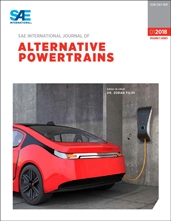Development of a Catalytic Converter Cool-Down Model to Investigate Intermittent Engine Operation in HEVs
- Content
- Catalytic converters, a primary component in most automotive emissions control systems, do not function well until they are heated substantially above ambient temperature. As the primary energy for catalyst heating comes from engine exhaust gases, plug-in hybrid electric vehicles (PHEVs) that have the potential for short and infrequent use of their onboard engine may have limited energy available for catalytic converter heating. This article presents a comparison of multiple hybrid supervisory control strategies to determine the ability to avoid engine cold starts during a blended charge-depleting propulsion mode. Full vehicle and catalytic converter simulations are performed in parallel with engine dynamometer testing in order to examine catalyst temperature variations during the course of the US06 City drive cycle. Emissions and energy consumption (E&EC) calculations are also performed to determine the effective number of engine starts during the drive cycle.
- Pages
- 16
- Citation
- Young, K., Jones, R., Hamley, A., Stoddard, J. et al., "Development of a Catalytic Converter Cool-Down Model to Investigate Intermittent Engine Operation in HEVs," SAE Int. J. Alt. Power. 7(2):139-154, 2018, https://doi.org/10.4271/08-07-02-0009.
